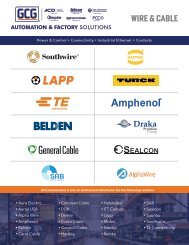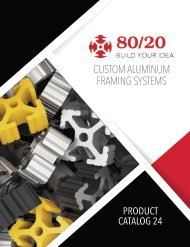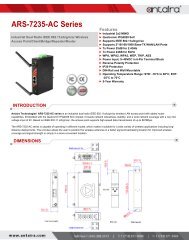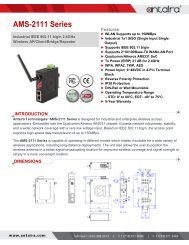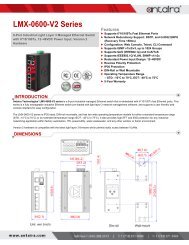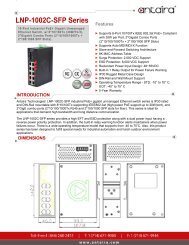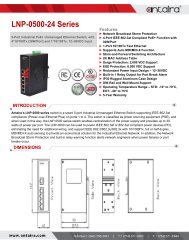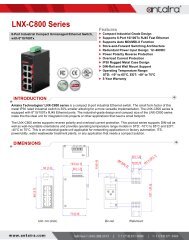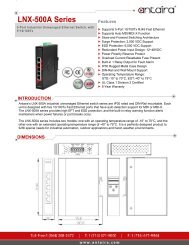PowerOhm Products for GE Fugi Drives
You also want an ePaper? Increase the reach of your titles
YUMPU automatically turns print PDFs into web optimized ePapers that Google loves.
POWEROHM<br />
Ω RESISTORS INC.<br />
Braking Resistors<br />
Brake Modules<br />
VBR Load Analyzer<br />
Manufactured <strong>for</strong><br />
<strong>GE</strong> Fuji <strong>Drives</strong><br />
(800) 838-4694<br />
www.powerohm.com
PO Box 537 Katy, TX 77492<br />
Phone: (800) 838-4694<br />
Fax: (859)-384-8099<br />
Email: sales@powerohm.com<br />
DRIVES<br />
C<br />
H<br />
O<br />
P<br />
P<br />
P<br />
E<br />
R<br />
S<br />
BRAKE RESISTORS<br />
S<br />
I<br />
Z<br />
I<br />
N<br />
G
2<br />
PO Box 537 Katy, TX 77492<br />
Phone: (800) 838-4694<br />
Fax: (859)-384-8099<br />
Email: sales@powerohm.com<br />
Powerohm Resistors is pleased to offer the first printing of the Powerohm Braking Resistor catalog <strong>for</strong> Fuji<br />
<strong>Drives</strong>. In addition to the comprehensive Dynamic Braking Resistor selection list, we have sections <strong>for</strong> the<br />
Powerohm Resistors new line of stand alone DB Modules/Choppers and the exciting new VBR, a<br />
diagnostic tool, which facilitates the proper selection and takes the mystery out of sizing Dynamic Braking<br />
Resistors.<br />
This comprehensive guide also offers complete in<strong>for</strong>mation on all the resistor selections including the panel<br />
mounted type CR case style resistors, to rugged style type screened or louvered enclosed units. All units<br />
are covered, and conveniently listed under the appropriate section by Voltage, HP, Duty Cycle.<br />
Once your part number is selected, additional technical in<strong>for</strong>mation such as ohms, watts, dimensions, weight<br />
and the list price of the unit may be found on page 19.<br />
Powerohm’s new DB Module/Chopper is listed on page 11. Models are available in continuous amp ratings<br />
of 50, 115, 450, and 600.<br />
Powerohm’s VBR takes the mystery out of sizing DB resistors. The light compact, portable unit will assist in<br />
sizing the proper DB Resistor <strong>for</strong> any of the Fuji <strong>Drives</strong> series. The unit may be purchased or rented from<br />
Powerohm Resistors Inc. A complete description of the unit’s operation is available on pages 12 thru 13,<br />
purchasing and rental in<strong>for</strong>mation is available on page 20.<br />
Finally, additional product in<strong>for</strong>mation such as Installation and Mounting instructions is included as well as<br />
other product in<strong>for</strong>mation pages and useful Application and Engineering Notes.<br />
Feel free to call Powerohm Resistors Inc. toll free at 1-800-838-4694 if you have any questions.
3<br />
PO Box 537 Katy, TX 77492<br />
Phone: (800) 838-4694<br />
Fax: (859)-384-8099<br />
Email: sales@powerohm.com<br />
Table of Contents<br />
Fuji <strong>Drives</strong> (All duty cycles)<br />
230V Standard Enclosed Resistors 4<br />
460V Standard Enclosed Resistors 5<br />
Resistor Tables<br />
230V Fuji Part Number Index 19<br />
460V Fuji Part Number Index 19<br />
DB White Paper 6 - 10<br />
Brake Module<br />
In<strong>for</strong>mation 11<br />
Pricing 20<br />
VBR In<strong>for</strong>mation<br />
In<strong>for</strong>mation 12 -13<br />
Pricing 20<br />
Enclosure Details<br />
GCE Enclosures 14<br />
ED Enclosures 15<br />
Installation Instructions 16 -17<br />
Engineering Notes 18
4<br />
PO Box 537 Katy, TX 77492<br />
Phone: (800) 838-4694<br />
Fax: (859)-384-8099<br />
Email: sales@powerohm.com<br />
230V Fuji Drive<br />
Standard Enclosed Resistors<br />
Volts<br />
Motor<br />
HP G11S Inverter<br />
Motor<br />
HP P11S Inverter Ohms Q'ty<br />
Powerohm<br />
P/N<br />
G11S %<br />
Torque<br />
P11S %<br />
Torque<br />
230 1/4 FRNF25G11S-2UX - - 100 1 PRDB0.75-2 150 -<br />
230 1/2 FRNF50G11S-2UX - - 100 1 PRDB0.75-2 150 -<br />
230 1 FRN001G11S-2UX - - 40 1 PRDB0.75-2 150 -<br />
230 2 FRN002G11S-2UX - - 40 1 PRDB2.2-2 150 -<br />
230 3 FRN003G11S-2UX - - 33 1 PRDB2.2-2 150 -<br />
230 5 FRN005G11S-2UX 7.5 FRN007P11S-2UX 33 1 PRDB3.7-2 150 100<br />
230 7.5 FRN007G11S-2UX 10 FRN010P11S-2UX 20 1 PRDB5.5-2 150 100<br />
230 10 FRN010G11S-2UX 15 FRN015P11S-2UX 15 1 PRDB7.5-2 150 100<br />
230 15 FRN015G11S-2UX 20 FRN020P11S-2UX 10 1 PRDB11-2 150 100<br />
230 20 FRN020G11S-2UX 25 FRN025P11S-2UX 8.6 1 PRDB15-2 150 100<br />
230 25 FRN025G11S-2UX 30 FRN030P11S-2UX 6.8 1 PRDB18.5-2 150 100<br />
230 30 FRN030G11S-2UX 40 FRN040P11S-2UX 5.8 1 PRDB22-2 150 100<br />
230 40 FRN040G11S-2UX 50 FRN050P11S-2UX 4 1 PRDB30-2C 100 75<br />
230 50 FRN050G11S-2UX 60 FRN060P11S-2UX 3 1 PRDB37-2C 100 75<br />
230 60 FRN060G11S-2UX 75 FRN075P11S-2UX 2.5 1 PRDB45-2C 100 75<br />
230 75 FRN075G11S-2UX 100 FRN100P11S-2UX 2 1 PRDB55-2C 100 75<br />
230 100 FRN100G11S-2UX 125 FRN125P11S-2UX 1.5 1 PRDB75-2C 100 75<br />
230 125 FRN125G11S-2UX 150 FRN150P11S-2UX 1.2 1 PRDB90-2C 100 75<br />
CONSTRUCTION NOTES:<br />
Enclosures have a mill galvanized finish.<br />
Resistance values have a +/- 10% tolerance.<br />
All enclosures include a terminal block <strong>for</strong> customer<br />
connections and a normally closed thermal switch.
5<br />
PO Box 537 Katy, TX 77492<br />
Phone: (800) 838-4694<br />
Fax: (859)-384-8099<br />
Email: sales@powerohm.com<br />
460V Fuji Drive<br />
Standard Enclosed Resistors<br />
Volts<br />
Motor<br />
HP G11S Inverter<br />
Motor<br />
HP P11S Inverter Ohms Q'ty<br />
Powerohm<br />
P/N<br />
G11S %<br />
Torque<br />
P11S %<br />
Torque<br />
460 1/2 FRNF50G11S-4UX - - 200 1 PRDB0.75-4 150 -<br />
460 1 FRN001G11S-4UX - - 200 1 PRDB0.75-4 150 -<br />
460 2 FRN002G11S-4UX - - 160 1 PRDB2.2-4 150 -<br />
460 3 FRN003G11S-4UX - - 160 1 PRDB2.2-4 150 -<br />
460 5 FRN005G11S-4UX 7.5 FRN007P11S-4UX 130 1 PRDB3.7-4 150 100<br />
460 7.5 FRN007G11S-4UX 10 FRN010P11S-4UX 80 1 PRDB5.5-4 150 100<br />
460 10 FRN010G11S-4UX 15 FRN015P11S-4UX 60 1 PRDB7.5-4 150 100<br />
460 15 FRN015G11S-4UX 20 FRN020P11S-4UX 40 1 PRDB11-4 150 100<br />
460 20 FRN020G11S-4UX 25 FRN025P11S-4UX 34.4 1 PRDB15-4 150 100<br />
460 25 FRN025G11S-4UX 30 FRN030P11S-4UX 27 1 PRDB18.5-4 150 100<br />
460 30 FRN030G11S-4UX 40 FRN040P11S-4UX 22 1 PRDB22-4 150 100<br />
460 40 FRN040G11S-4UX 50 FRN050P11S-4UX 15 1 PRDB30-4C 100 75<br />
460 50 FRN050G11S-4UX 60 FRN060P11S-4UX 12 1 PRDB37-4C 100 75<br />
460 60 FRN060G11S-4UX 75 FRN075P11S-4UX 10 1 PRDB45-4C 100 75<br />
460 75 FRN075G11S-4UX 100 FRN100P11S-4UX 7.5 1 PRDB55-4C 100 75<br />
460 100 FRN100G11S-4UX 125 FRN125P11S-4UX 6.5 1 PRDB75-4C 100 75<br />
460 125 FRN125G11S-4UX 150 FRN150P11S-4UX 4.7 1 PRDB110-4C 100 75<br />
460 150 FRN150G11S-4UX 200 FRN200P11S-4UX 4.7 1 PRDB110-4C 100 75<br />
460 200 FRN200G11S-4UX 250 FRN250P11S-4UX 3.9 1 PRDB132-4C 100 75<br />
460 250 FRN250G11S-4UX 300 FRN300P11S-4UX 3.2 1 PRDB160-4C 100 75<br />
460 300 FRN300G11S-4UX 350 FRN350P11S-4UX 2.6 1 PRDB200-4C 100 75<br />
460 350 FRN350G11S-4UX 400 FRN400P11S-4UX 2.2 1 PRDB220-4C 100 75<br />
460 400 FRN400G11S-4UX 450 FRN450P11S-4UX 3.2 2 PRDB160-4C 100 75<br />
460 450 FRN450G11S-4UX 500 FRN500P11S-4UX 3.2 2 PRDB160-4C 100 75<br />
460 500 FRN500G11S-4UX 600 FRN600P11S-4UX 2.6 2 PRDB200-4C 100 75<br />
460 600 FRN600G11S-4UX 700 FRN700P11S-4UX 2.6 2 PRDB200-4C 100 75<br />
460 - - 800 FRN800P11S-4UX 2.6 2 PRDB200-4C 100 75<br />
CONSTRUCTION NOTES:<br />
Enclosures have a mill galvanized finish.<br />
Resistance values have a +/- 10% tolerance.<br />
All enclosures include a terminal block <strong>for</strong> customer<br />
connections and a normally closed thermal switch.
6<br />
PO Box 537 Katy, TX 77492<br />
Phone: (800) 838-4694<br />
Fax: (859)-384-8099<br />
Email: sales@powerohm.com<br />
SIZING AND DESIGN CONSIDERATIONS FOR POWER RESISTORS USED IN<br />
DYNAMIC BRAKING APPLICATIONS ON VARIABLE FREQUENCY DRIVES<br />
Abstract<br />
VFD’s operated in Constant Torque applications often employ the use of dynamic braking resistors to allow<br />
faster process and product cycle times that otherwise would be unattainable. For safety code reasons, including<br />
personnel and equipment, particular processes may need to have a quick stop feature so the process is<br />
terminated quickly.<br />
This paper will examine the design considerations <strong>for</strong> braking resistors when used in both of the above<br />
applications. The paper also examines and suggests the proper element type that might be used as well as<br />
other options. Increasing the throughput rates of processes (increased efficiency) and safety considerations<br />
(quick process stops) <strong>for</strong> equipment and personnel, will also be examined.<br />
The Problem Described<br />
Efficiency and flow through rates may sometimes seem to be at a fixed upper end speed range. Increasing<br />
these maximum speeds without giving consideration to the inertia may cause nuisance tripping of the VFD and<br />
thus the process. Simply by decreasing the deceleration time to increase the overall process time, may not be<br />
possible without a resistive load due to the inertia present in the system.<br />
Secondly, quickly terminating and shutting down a process <strong>for</strong> equipment and personnel safety and code<br />
considerations may also be desired.<br />
The choice of the proper dynamic braking resistor would provide the solution <strong>for</strong> both of these situations.<br />
Constant Torque Processes<br />
Some constant torque processes may be operated in speed/torque quadrants that oppose one another. Figure 1<br />
shows a typical four quadrant graph of a drive. In Quadrants I and II, regeneration of energy from the load (a<br />
counter emf) is generated back through the motor. The motor, in essence, becomes a generator. This<br />
regenerated energy looks to the connected Drive <strong>for</strong> the opportunity to dissipate itself. The Drive is able to<br />
absorb some of this energy in the bus capacitors but is unable to sustain this condition <strong>for</strong> large loads or long<br />
periods without the need to rid itself of this over-voltage situation.<br />
Concurrently, when processes need to be quickly terminated <strong>for</strong> the safety of personnel and equipment, the<br />
inertia in the system may cause an over-voltage fault in the drive if decelerated too quickly. Many applications,<br />
by safety code, must be terminated in a predetermined period. Also, when retrofitting or installing a VFD in<br />
place of an existing mechanical or DC system, it is very important to obtain the total inertia that would affect the<br />
desired braking time.
7<br />
PO Box 537 Katy, TX 77492<br />
Phone: (800) 838-4694<br />
Fax: (859)-384-8099<br />
Email: sales@powerohm.com<br />
Torque (+)<br />
Speed (-)<br />
Quadrant II<br />
• Regeneration<br />
• Speed –<br />
• Torque +<br />
Quadrant I<br />
• Motoring<br />
• Speed +<br />
• Speed –<br />
Speed (+)<br />
Quadrant III<br />
• Motoring<br />
• Speed –<br />
• Torque –<br />
Quadrant IV<br />
• Regeneration<br />
• Speed +<br />
• Torque –<br />
Torque (-)<br />
Figure 1<br />
Resistor Element Type Options<br />
The type of resistor element to be used in a braking resistor application is a function of braking current and the<br />
duty cycle. The continuous current rating of the braking resistor is derived from calculations based on the duty<br />
cycle along with considerations of the Brake IGBT built in the drive or the IGBT in the external brake chopper.<br />
The proper ohm value is chosen based on the torque requirements of the application along with considerations<br />
of the current rating of the IGBT. The selected resistance value must be greater than the minimum resistance<br />
specified <strong>for</strong> the drive. Installing a braking resistor with too low of a resistance value may violate the maximum<br />
current rating of the IGBT and cause permanent damage to the drive.<br />
There are many types of element options available <strong>for</strong> selection. The proper selection is important to insure<br />
per<strong>for</strong>mance and reliability as well as to provide the most compact and economical package. Note that the ohm<br />
value and continuous amp rating of the resistor is inversely proportional to one another. In other words, in a<br />
typical family of element types while maintaining the same approximate overall size, the higher the ohm rating of<br />
given resistor element, the lower the current rating.<br />
The following element selection chart provides an approximate guide to use <strong>for</strong> the proper selection of natural<br />
convection cooled resistors. This example is <strong>for</strong> a 460 volt VFD.<br />
HP Duty Cycle Range Element type<br />
1-25 up to 10% Case style, Smoothwound or Wirewound<br />
1-25 above 10% Wirewound or Edgewound<br />
30-75 up to 10% Wirewound or Edgewound<br />
30-75 above 10% Wirewound, Edgewound or Grid<br />
100 and up up to 10% Edgewound, Grid or Ribbon<br />
100 and up above 10% Edgewound, Grid or Ribbon
8<br />
PO Box 537 Katy, TX 77492<br />
Phone: (800) 838-4694<br />
Fax: (859)-384-8099<br />
Email: sales@powerohm.com<br />
Series Connections Versus Parallel Connections<br />
According to Ohm’s Law, the same total ohm value of a braking resistor circuit can be obtained using either a<br />
series or a parallel connection of elements. However, the thermal mass (active element weight) of the series<br />
connection is much greater than the equivalent parallel connection because the series connected resistors<br />
feature a larger cross-sectional element to manage its higher current rating.<br />
Figure 2 shows a pair of 50 ohm resistors connected in series <strong>for</strong> an equivalent resistance of 100 ohms. Figure<br />
3 shows a pair of 200 ohm resistors connected in parallel <strong>for</strong> an equivalent resistance of 100 ohms. Both<br />
configurations have the same equivalent resistance, however, are the configurations equal when applied in a<br />
VFD cyclic braking application? The answer is absolutely not!<br />
To demonstrate more clearly, we shall examine the test results <strong>for</strong> both the series connected resistor<br />
configuration with the parallel connected resistor configuration while subjected to a repeat cycle as well as a<br />
single shot or quick stop.<br />
R1<br />
R2<br />
R1<br />
R2<br />
Figure 2<br />
Figure 3<br />
Repeat Cycle Applications involve a duty cycle. Typically, the resistor is overloaded <strong>for</strong> a few seconds and then<br />
allowed to cool <strong>for</strong> several more seconds. This cycle of on time and off time repeats indefinitely. After multiple<br />
cycles, the resistor stabilizes between two temperatures. The highest temperature occurs at the end of the on<br />
(or heating) cycle and the lowest temperature occurs at the end of the off (or cooling) cycle. The off time is<br />
typically longer than the on time <strong>for</strong> most repeat cycle applications such as motor control.<br />
Single Shot or Quick Stop Applications involve absorbing large amounts of energy in a short period of time and<br />
then allowing the resistor to completely cool down to ambient temperature. A good example is an emergency<br />
stop application.
9<br />
PO Box 537 Katy, TX 77492<br />
Phone: (800) 838-4694<br />
Fax: (859)-384-8099<br />
Email: sales@powerohm.com<br />
Repeat Cycle Test Comparison<br />
Figure 4 illustrates the corresponding element temperatures <strong>for</strong> a 50% duty cycle application, (5 seconds on/ 5<br />
seconds off), <strong>for</strong> both the series and parallel connection while subjected to the same voltage and overall current<br />
flow. As noted, both circuits equal 100 ohms total, but the active element weight of the series connection is 3<br />
times greater than the parallel connection giving it an advantage. Why is this important? The answer is the watt<br />
second capability of the resistor unit. Notice the element temperature rise of the series circuit is operating much<br />
lower than the equivalent parallel circuit. The total element mass of the series connected unit has a watt second<br />
rating equivalent to approximately 3 times the parallel unit in this given example. The higher the watt second<br />
rating of a resistor assembly, the lower temperature rise, the longer the life expectancy.<br />
Series Vs. Parallel<br />
(Intermitten Duty)<br />
300<br />
Temp (Deg C)<br />
250<br />
200<br />
150<br />
100<br />
50<br />
0<br />
0:00 1:12 2:24 3:36 4:48<br />
Time (minutes)<br />
Series<br />
Parallel<br />
Figure 4
10<br />
PO Box 537 Katy, TX 77492<br />
Phone: (800) 838-4694<br />
Fax: (859)-384-8099<br />
Email: sales@powerohm.com<br />
One Shot Cycle Test Comparison<br />
Figure 5 illustrates the corresponding element temperatures <strong>for</strong> a single shot application. The graph shows the<br />
temperature comparisons <strong>for</strong> both the series and parallel configurations while subjected to the same overall<br />
current flow and the same ON time. The test was stopped once the parallel configuration reached its full<br />
temperature rise of 375 degrees Celsius. As noted, both circuits equal 100 ohms total, but the active element<br />
weight of the series connection is 3 times greater than the parallel connection giving it an advantage. As you<br />
can see from the graph the series configuration’s temperature rise was much lower than the equivalent parallel<br />
circuit. The total element mass of the series connected unit has a watt second rating equivalent to approximately<br />
3 times the parallel unit in this given example. Once again, the higher the watt second rating of a resistor<br />
assembly, the lower temperature rise, the better the reliability.<br />
Series Vs. Parallel<br />
(Single Shot)<br />
TEMP (deg C)<br />
450<br />
400<br />
350<br />
300<br />
250<br />
200<br />
150<br />
100<br />
50<br />
0<br />
0 2 4 6 8 10<br />
Time (sec)<br />
Parallel<br />
Series<br />
Figure 5
11<br />
PO Box 537 Katy, TX 77492<br />
Phone: (800) 838-4694<br />
Fax: (859)-384-8099<br />
Email: sales@powerohm.com<br />
Powerohm Type BM Braking Modules<br />
PRODUCT OVERVIEW<br />
Powerohm Type BM Braking Modules can be used in<br />
conjunction with any AC drive to monitor the DC bus<br />
of the drive and activate external braking resistor as<br />
needed not only to avoid over-voltage trips, but to<br />
greatly improve the per<strong>for</strong>mance of the drive system.<br />
The use of Braking Modules and resistors increase<br />
the braking torque capability of a variable frequency<br />
drive, allowing faster and more controlled<br />
deceleration times.<br />
To accommodate system horsepower requirements<br />
beyond the capability of a single Module, the<br />
Modules are all Master/Slave programmable. This<br />
allows an arrangement of multiple Modules to<br />
effectively function as a single higher rated module.<br />
Pricing <strong>for</strong> the Brake Modules appears on page 20,<br />
while the pricing <strong>for</strong> the resistors may be found in the<br />
resistor index page 19.<br />
<strong>GE</strong>NERAL SPECIFICATIONS<br />
The Powerohm Type BM Braking Module is available<br />
in three different voltage classes including 240, 480<br />
and 600 volts.<br />
Powerohm<br />
Part No.<br />
Nominal<br />
AC Line<br />
Voltage<br />
RMS<br />
Continuous<br />
Load<br />
Current<br />
Turn ON<br />
Voltage<br />
Max Peak<br />
Current<br />
BM2-50 240 50 390 200<br />
BM2-115 240 115 390 200<br />
BM240-450 240 450 390 600<br />
BM240-600 240 600 390 900<br />
BM4-50 480 50 775 200<br />
BM4-115 480 115 775 200<br />
BM480-450 480 450 775 600<br />
BM480-600 480 600 775 900<br />
BM6-50 600 50 970 200<br />
BM6-115 600 115 970 200<br />
BM600-450 600 450 970 600<br />
BM600-600 600 600 970 900
12<br />
PO Box 537 Katy, TX 77492<br />
Phone: (800) 838-4694<br />
Fax: (859)-384-8099<br />
Email: sales@powerohm.com<br />
VBR<br />
Variable Braking Resistor Analyzer<br />
Available <strong>for</strong> Rent or Purchase<br />
With the VBR you can:<br />
• Correctly size the OHMS and WATTS <strong>for</strong> any application<br />
• Quickly provide a DB Resistor Sizing Service <strong>for</strong> your customers<br />
• Provide a temporary DB solution while the permanent is on its way<br />
• Validate the existing resistor size being employed as the optimum choice<br />
• Provide OEM’s and Integrator’s with a portable / adjustable diagnostic tool <strong>for</strong><br />
sizing braking resistors.
13<br />
PO Box 537 Katy, TX 77492<br />
Phone: (800) 838-4694<br />
Fax: (859)-384-8099<br />
Email: sales@powerohm.com<br />
VBR Operation<br />
CAUTION: Reference the Drive Manual and the Powerohm Braking Resistor Manual when<br />
selecting the proper resistance value. Do not select resistance values below the minimum<br />
values listed <strong>for</strong> the drive. Selecting a resistance value below the minimum will result in<br />
failure of the brake IGBT and/or drive.<br />
Step 1. Secure the VBR unit in place and plug in supplied power cord to a 120VAC source<br />
be<strong>for</strong>e connecting load leads to drive or braking module. Attach the supplied load lead<br />
cables to the drive by connecting the red lead to DC+ and the black lead to DC-. Warning:<br />
Drive power and DC bus must be OFF be<strong>for</strong>e connecting the loads leads.<br />
Step 2. Turn power selector switch to the ON position to activate the VBR unit. (Fig 1.)<br />
The selector switch should illuminate green and blowers should function when ON. Insure<br />
that there is a minimum clearance of 24 inches beyond the exhaust to any non-flammable<br />
surfaces.<br />
Step 3. If the drive has an existing braking resistor installed, it is important to not press the<br />
“Braking Enable” pushbutton. Enabling a selected resistor value may push the equivalent<br />
resistance below the minimum allowed. Note that the VBR can be used to analyze an<br />
existing braking resistor to determine if a more effective resistor could be used <strong>for</strong> the<br />
installation (skip to Step 5 if this is the case).<br />
Figure 1.<br />
Step 4. Select a desired resistance value and press “Braking Enable” to activate the<br />
resistive load. (Fig 2.) It is critical that the resistance value selected is greater than the<br />
minimum resistance value specified by the drive or braking module manufacturer. Selecting<br />
a resistance value lower than the minimum may cause permanent damage to the drive or<br />
braking module. The VBR is now ready to monitor your braking cycle.<br />
Step 5. Start and run the Drive at full load, through its entire motoring and braking cycles <strong>for</strong><br />
a minimum of 30 minutes. To prevent under sizing the resistor, be sure to operate at<br />
maximum load in combination with the most sever duty cycle. During the cycling of the<br />
Drive you will notice that “VBR Reading” will begin to register a readout from 1 to 135. (Fig<br />
3.)<br />
Figure 2.<br />
Figure 3.<br />
Step 6. It is important to run the Drive a minimum of 30 minutes so that the proper watt<br />
selection of the resistor is realized. At this time the “VBR Reading” should have reached its<br />
maximum value and you are you are ready to record the peak “VBR Reading.” Lift off the<br />
small cover below the digital readout to access the programming keys. Press the up arrow<br />
key, which is the second key from the left. This blinking number displayed is the peak<br />
readout that will be used in sizing your braking resistor.<br />
Step 7. With the resistance value you selected in Step 4 (or the value of an existing braking<br />
resistor) and the peak “VBR Reading” you recorded from Step 6, you can now properly<br />
select a fixed resistor <strong>for</strong> your application. Go to the VBR resistor selection chart to obtain<br />
the correct braking resistor part number.<br />
Step 8. The VBR unit must remain ON a minimum of 5 minutes after the drive is powered<br />
down to allow the unit to cool. Do not remove load leads until the Drive and DC bus have<br />
been powered down. Use caution when handling the VBR unit as the exhaust area surface<br />
may be HOT!
14<br />
PO Box 537 Katy, TX 77492<br />
Phone: (800) 838-4694<br />
Fax: (859)-384-8099<br />
Email: sales@powerohm.com<br />
Type GCE Enclosures<br />
These heavy gage screened enclosures feature a solid bottom and a built-in compartment separated from the resistor<br />
assembly. The resistors are factory wired to a terminal block mounted in this compartment using high temperature Teflon<br />
or silicone wire. The terminal compartment also houses a normally closed thermal switch used <strong>for</strong> detecting resistor<br />
temperature overloads. During installation, standard 90ºC rated wire is routed into the compartment through the removable<br />
1/2 inch conduit knockouts and connected to the factory wired terminal block.<br />
Our standard unit includes a screened cover which is CNC punched to obtain maximum cooling and professional<br />
aesthetics. Mounting holes are located inside the enclosure and can be easily accessed by removing the cover. Resistor<br />
coils are interconnected using stainless steel bus bars, producing a corrosion resistant current path to withstand nearly any<br />
harsh industrial environment. The standard finish is galvanized, but an optional ANSI 61 powder coated finish is available<br />
upon request. As shown in the table below, the size of the enclosure will vary depending on the number of resistor coils<br />
required <strong>for</strong> your application. Please do not hesitate to call the factory if you need assistance. Units are available with<br />
louvered covers; add "-W" to the part number and note that the 'A' and 'B' dimensions will increase by 2 inches and the ‘C’<br />
dimension will increase by 1 inch.<br />
GCE ENCLOSURE DIMENSIONS AND COIL OPTIONS<br />
PART MAX. NO. MAX NO. DIMENSIONS IN INCHES<br />
NUMBER WR COLS SXR,VR or ER A B C D E<br />
GCE1 1 (1) Size 2 12 5 5 10-1/2 ---<br />
GCE2 2 (2) Size 2 12 7 5 10-1/2 4-1/2<br />
GCE3 3 (3) Size 2 12 10 5 10-1/2 7-1/2<br />
GCE4 4 (4) Size 2 12 13 5 10-1/2 10-1/2<br />
GCE5 5 (5) Size 2 12 16 5 10-1/2 13-1/2<br />
GCE6 6 (3) Size 5 19 10 5 17-1/2 7-1/2<br />
GCE8 8 (4) Size 5 19 13 5 17-1/2 10-1/2<br />
GCE9 9 (3) Size 7 26-1/2 10 5 25 7-1/2<br />
GCE10 10 (5) Size 5 19 16 5 17-1/2 13-1/2<br />
GCE12 12 (4) Size 7 26-1/2 13 5 25 10-1/2<br />
GCE15 15 (5) Size 7 26-1/2 16 5 25 13-1/2<br />
GCE18 18 (6) Size 7 28 10 10 26-1/2 7-1/2<br />
GCE24 24 (8) Size 7 28 13 10 26-1/2 10-1/2<br />
GCE30 30 (10) Size 7 28 16 10 26-1/2 13-1/2<br />
(4) 7/16 DIA.<br />
TOP VIEW<br />
LEFT SIDE VIEW<br />
NORMALLY CLOSED<br />
THERMOSTAT<br />
TWO POINT<br />
TERMINAL BLOCK<br />
E<br />
B<br />
C<br />
B<br />
D<br />
A
15<br />
PO Box 537 Katy, TX 77492<br />
Phone: (800) 838-4694<br />
Fax: (859)-384-8099<br />
Email: sales@powerohm.com<br />
Type ED Enclosures<br />
The Type ED enclosure is designed <strong>for</strong> applications requiring a large number of Type SXR, WR, VR and/or ER resistor<br />
coils. In addition to the large capacity, these units are supplied with terminal connections up to 400 amps continuous<br />
located on a terminal plate in the bottom of the enclosure. These factory wired connections allow standard 90ºC rated wire<br />
to be used if routed along the enclosure bottom. If installing without the optional terminal connections, always use 200ºC<br />
rated silicone or Teflon wire when attaching directly to resistors. A normally closed thermal switch is also provided, which is<br />
used to detect resistor temperature overloads.<br />
These rigid enclosures include a screened top and removable front and back screened covers. The enclosure sides are<br />
solid and the bottom is open and furnished with two lifting eyes. Mounting holes are located inside the enclosure and can<br />
be easily accessed by removing the front or rear cover. Resistor coils are interconnected using all stainless steel bus bars,<br />
producing a corrosion resistant current path to withstand nearly any harsh industrial environment. The standard finish is<br />
galvanized, but an optional ANSI 61 powder coated finish is available upon request. As shown in the table below, the size<br />
of the enclosure will vary depending on the number of resistor coils required <strong>for</strong> your application. Units are available with<br />
louvered covers; add "-W" to the part number and note that the 'A' and 'B' dimensions will increase by 4 inches and the ‘C’<br />
dimensions will increase by 1-1/2 inches.<br />
ED ENCLOSURE DIMENSIONS AND COIL OPTIONS<br />
PART MAX. NO. MAX NO. DIMENSIONS IN INCHES<br />
NUMBER WR COLS SXR,VR or ER A B C D E<br />
ED1 18 (9) Size 5 30 18 10 26 16<br />
ED2 36 (18) Size 5 30 18 16 26 16<br />
ED3 54 (27) Size 5 30 18 24 26 16<br />
ED4 72 (36) Size 5 30 18 32 26 16<br />
ED5 90 (45) Size 5 30 18 40 26 16<br />
ED6 108 (54) Size 5 30 18 48 26 16<br />
ED7 126 (63) Size 5 30 18 56 26 16<br />
ED8 144 (72) Size 5 30 18 64 26 16<br />
ED9 162 (81) Size 5 30 18 72 26 16<br />
ED10 180 (90) Size 5 30 18 80 26 16<br />
FRONT VIEW<br />
SIDE VIEW<br />
C<br />
NORMALLY CLOSED<br />
THERMOSTAT<br />
TWO POINT<br />
TERMINAL BLOCK<br />
D<br />
A<br />
E<br />
B<br />
(4) 5/8 DIA. MTG. HOLES
16<br />
PO Box 537 Katy, TX 77492<br />
Phone: (800) 838-4694<br />
Fax: (859)-384-8099<br />
Email: sales@powerohm.com<br />
Installation Instructions<br />
Construction: Powerohm braking resistors consists of smoothwound, wirewound or edgewound type<br />
resistor coils mounted in ventilated enclosures. All current carrying components used to manufacture our<br />
resistor coils including the elements and terminals are stainless steel <strong>for</strong> maximum corrosion resistance.<br />
Standard enclosures will be mill galvanized with terminals factory wired to a terminal block and normally<br />
closed thermal switch. Braking resistors are available with a variety of options such as special enclosure<br />
finishes and outdoor ratings.<br />
INSPECTION: Upon receipt of your Powerohm Braking Resistor, be sure to inspect the unit carefully <strong>for</strong><br />
any shipping damage. After unpacking, check the unit <strong>for</strong> loose, broken, bent or otherwise damaged parts<br />
due to shipping. Report any shipping damage immediately to the freight carrier. Be sure to verify that the<br />
part number and ratings listed on the nameplate con<strong>for</strong>m to the order specification. The ohm rating listed<br />
on the nameplate is critical (too low of an ohm value may cause damage to the drive).<br />
INSTALLATION:<br />
IMPORTANT: The National Electric Code (NEC) and local regulations govern the installation and<br />
wiring of electrical equipment such as braking resistors. DC power wiring, AC power wiring,<br />
control wiring and conduit must be installed in accordance with these codes.<br />
Powerohm braking assemblies cool by natural convection causing hot air to rise vertically from the<br />
enclosure. Braking resistors should be mounted in a well ventilated location free of any combustible<br />
materials or equipment affected by heat. Units should be installed with at least 24 inches of free space<br />
above the enclosure top and 6 inches of free space surrounding the enclosure sides. If necessary, units<br />
can be mounted on spacers or channels to limit heat from conducting from the resistor enclosure to its<br />
mounting surface.<br />
Braking resistor enclosures 28 inches or less in width, can be mounted vertically or horizontally. If the<br />
unit is mounted vertically, it is important that the resistor coils remain in a horizontal position. Also, if a<br />
thermal switch is included with the unit, position the equipment so the switch remains near the top of the<br />
enclosure. See below <strong>for</strong> vertical mounting details.<br />
TOP VIEW<br />
NORMALLY CLOSED<br />
THERMAL SWITCH<br />
(4) 7/16 DIA.<br />
AIR FLOW<br />
Correct Vertical<br />
Mounting<br />
(Front View)<br />
Incorrect Vertical<br />
Mounting<br />
(Front View)<br />
To install the unit, first remove the ventilated cover. Units 28 inches or less in width require a 5/16 inch<br />
wrench, while larger units require a 7/16 inch wrench to remove the cover hardware. Mounting holes can<br />
be found on the inside of the braking resistor enclosure. Mounting dimensions are listed on pages 25-36.<br />
Units that are 28 inches or smaller have 7/16 inch diameter mounting holes designed <strong>for</strong> 3/8 inch<br />
hardware. 30 inch wide units have 5/8 inch diameter mounting holes designed <strong>for</strong> 1/2 inch hardware. Be<br />
sure to fasten the unit securely in place.
17<br />
PO Box 537 Katy, TX 77492<br />
Phone: (800) 838-4694<br />
Fax: (859)-384-8099<br />
Email: sales@powerohm.com<br />
Smaller 28 inch wide enclosures have convenient conduit knockouts <strong>for</strong> easy connection. Remove the<br />
proper knockout after determining a suitable entry point. Larger units may require field punching <strong>for</strong><br />
conduit entry. It is preferable to route conduit near the bottom of the resistor enclosure. After attaching<br />
conduit, pull wiring into the enclosure <strong>for</strong> connection to resistor. If connecting directly to the terminals on<br />
the resistor elements, it is necessary to use high temperature silicon or Teflon wire rated 200ºC. Try to<br />
route wiring along the bottom of the enclosure and avoid running the wiring across the top or near the<br />
resistor elements. Units are supplied with either #10, 3/8 or 1/2 inch terminal hardware. If you choose to<br />
use the factory installed terminal block, then you may connect to it using standard 90ºC rated wire. Be<br />
sure to properly ground the resistor enclosure to prevent electrical shock.<br />
A normally closed thermal switch is included with the unit, featuring ¼ inch quick connect terminals.<br />
After installing and wiring to your Powerohm Braking Resistor, return the ventilated cover to its proper<br />
position. Securely tighten cover hardware (do not exceed 20 inch-pounds of torque).<br />
MAINTENANCE: Periodically check the unit <strong>for</strong> loose connections and an accumulation of dust or dirt on<br />
the inside and outside of the resistor enclosure. Be sure to allow the unit to cool be<strong>for</strong>e servicing<br />
(contact may result in burn injury). Remove all power be<strong>for</strong>e servicing unit to avoid electrical shock.<br />
Allow at least one minute after input power has been removed <strong>for</strong> the bus voltage to discharge. Electric<br />
shock can cause injury or death.<br />
Resistor elements should not glow red under normal operating conditions. If the resistor elements glow<br />
red you may need a higher rated braking resistor.<br />
TECHNICAL SUPPORT: If you have any questions about your braking resistor, contact Powerohm <strong>for</strong><br />
assistance at (800) 838-4694.
PO Box 537 Katy, TX 77492<br />
Phone: (800) 838-4694<br />
Fax: (859)-384-8099<br />
Email: sales@powerohm.com<br />
Application / Engineering Notes<br />
1) ND HP = Normal duty HP rating of the drive<br />
2) Torque (% of Motor) = Maximum torque (power) a motor can discharge back through the drive<br />
3) Rated Ohms = the nominal resistance value designed to exceed the minimum resistance rating of the drive. Any listed<br />
torque rating less than 100% is due to the limitations of the drive. Applications requiring torque values that exceed the<br />
limitations of the drive, may require an external chopper module and a corresponding resistor.<br />
5) Duty cycle %. The duty cycle and braking scheme determine the power rating (watts) and there<strong>for</strong>e the physical size of<br />
the braking resistor. Duty cycle is calculated by dividing the braking stop time by the total cycle time. Maximum cycle time<br />
is 2 minutes.<br />
All resistors assemblies come mounted in a screened guarded enclosure<br />
and include a prewired terminal block and a normally closed thermal switch.<br />
For outdoor enclosures add 10% to the price and –W to the part number.<br />
The standard enclosure finish is mill galvanized, however other finishes are<br />
available. Consult factory.<br />
18
PO Box 537 Katy, TX 77492<br />
Phone: (800) 838-4694<br />
Fax: (859)-384-8099<br />
Email: sales@powerohm.com<br />
230V Fuji Standard Enclosed Part Number Index<br />
Powerohm P/N Ohms Watts Encl Qty Encl P/N Dimensions Weight (lbs) List<br />
PRDB0.75-2 100 100 1 GCE1 12W x 5D x 5H 7 $135.00<br />
PRDB0.75-2C 100 100 1 GCE1 12W x 5D x 5H 7 $135.00<br />
PRDB2.2-2 40 290 1 GCE1 12W x 5D x 5H 7 $137.00<br />
PRDB2.2-2C 40 290 1 GCE1 12W x 5D x 5H 7 $137.00<br />
PRDB3.7-2 33 490 1 GCE2 12W x 7D x 5H 9 $207.00<br />
PRDB3.7-2C 33 490 1 GCE2 12W x 7D x 5H 9 $207.00<br />
PRDB5.5-2 20 730 1 GCE2 12W x 7D x 5H 9 $207.00<br />
PRDB7.5-2 15 990 1 GCE3 12W x 10D x 5H 13 $266.00<br />
PRDB11-2 10 1450 1 GCE4 12W x 13D x 5H 16 $325.00<br />
PRDB15-2 8.6 1980 1 GCE5 12W x 16D x 5H 18 $383.00<br />
PRDB18.5-2 6.8 2440 1 GCE6 19W x 10D x 5H 17 $398.00<br />
PRDB22-2 5.8 2900 1 GCE6 19W x 10D x 5H 19 $484.00<br />
PRDB30-2C 4 3960 1 GCE8 19W x 13D x 5H 27 $593.00<br />
PRDB37-2C 3 4880 1 GCE8 19W x 13D x 5H 28 $633.00<br />
PRDB45-2C 2.5 5940 1 GCE10 19W x 16D x 5H 37 $774.00<br />
PRDB55-2C 2 7260 1 GCE10 19W x 16D x 5H 40 $774.00<br />
PRDB75-2C 1.5 9900 1 GCE15 26.5W x 16D x 5H 55 $1,135.00<br />
PRDB90-2C 1.2 11800 1 GCE15 26.5W x 16D x 5H 59 $1,135.00<br />
460V Fuji Standard Enclosed Part Number Index<br />
Powerohm P/N Ohms Watts Encl Qty Encl P/N Dimensions Weight (lbs) List<br />
PRDB0.75-4 200 100 1 GCE1 12W x 5D x 5H 7 $135.00<br />
PRDB0.75-4C 100 1 GCE1 12W x 5D x 5H 7 $135.00<br />
PRDB2.2-4 160 290 1 GCE1 12W x 5D x 5H 7 $137.00<br />
PRDB2.2-4C 160 290 1 GCE1 12W x 5D x 5H 7 $137.00<br />
PRDB3.7-4 130 490 1 GCE2 12W x 7D x 5H 9 $207.00<br />
PRDB3.7-4C 130 490 1 GCE2 12W x 7D x 5H 9 $207.00<br />
PRDB5.5-4 80 730 1 GCE2 12W x 7D x 5H 9 $207.00<br />
PRDB7.5-4 60 990 1 GCE3 12W x 10D x 5H 13 $266.00<br />
PRDB11-4 40 1450 1 GCE4 12W x 13D x 5H 16 $325.00<br />
PRDB15-4 34.4 1980 1 GCE5 12W x 16D x 5H 18 $383.00<br />
PRDB18.5-4 27 2250 1 GCE6 19W x 10D x 5H 20 $442.00<br />
PRDB22-4 22 2900 1 GCE8 19W x 13D x 5H 26 $537.00<br />
PRDB30-4C 15 3960 1 GCE8 19W x 13D x 5H 24 $593.00<br />
PRDB37-4C 12 4880 1 GCE8 19W x 13D x 5H 24 $593.00<br />
PRDB45-4C 10 5860 1 GCE9 26.5W x 10D x 5H 26 $599.00<br />
PRDB55-4C 7.5 7260 1 GCE15 26.5W x 16D x 5H 38 $885.00<br />
PRDB75-4C 6.5 9900 1 GCE24 28W x 13D x 10H 55 $1,294.00<br />
PRDB110-4C 4.7 14520 1 GCE24 28W x 13D x 10H 74 $1,419.00<br />
PRDB132-4C 3.9 17420 1 GCE24 28W x 13D x 10H 82 $1,691.00<br />
PRDB160-4C 3.2 21120 1 ED2 30W x 18D x 16H 122 $2,410.00<br />
PRDB200-4C 2.6 29040 1 ED2 30W x 18D x 16H 131 $2,410.00<br />
PRDB220-4C 2.2 29040 1 ED3 30W x 18D x 24H 151 $2,818.00<br />
All standard enclosed resistors assemblies come mounted in a screened<br />
guarded enclosure and include a prewired terminal block and a normally<br />
closed thermal switch.<br />
19<br />
For outdoor enclosures add 10% to the price and –W to the part number.<br />
The standard enclosure finish is mill galvanized, however other finishes are<br />
available. Consult factory.
PO Box 537 Katy, TX 77492<br />
Phone: (800) 838-4694<br />
Fax: (859)-384-8099<br />
Email: sales@powerohm.com<br />
TYPE BM BRAKE MODULES<br />
Brake Module<br />
P/N<br />
Drive<br />
Input<br />
Voltage<br />
Minimum<br />
Ohms<br />
Continuous<br />
Amps<br />
Peak<br />
Amps Dimensions Weight (lbs) List Price<br />
BM2-50 200 – 240 1.95 50 200 7” x 11” x 5” 8 $1,280<br />
BM2-115 200 – 240 1.95 115 200 7” x 13” x 5” 10 $1,420<br />
BM240-450 200 – 240 0.65 450 600 7” x 20” x 10” 38 $5,284<br />
BM240-600 200 – 240 0.43 600 900 7” x 20” x 10” 38 $6,894<br />
BM4-50 395 – 480 3.88 50 200 7” x 11” x 5” 8 $1,280<br />
BM4-115 395 – 480 3.88 115 200 7” x 13” x 5” 10 $1,420<br />
BM480-450 395 – 480 1.29 450 600 7” x 20” x 10” 38 $5,654<br />
BM480-600 395 – 480 0.86 600 900 7” x 20” x 10” 38 $7,377<br />
BM6-50 500 – 600 4.85 50 200 7” x 11” x 5” 8 $1,280<br />
BM6-115 500 – 600 4.85 115 200 7” x 13” x 5” 10 $1,420<br />
BM600-450 500 – 600 1.62 450 600 7” x 20” x 10” 38 $5,654<br />
BM600-600 500 – 600 1.08 600 900 7” x 20” x 10” 38 $7,377<br />
VBR LOAD ANALYZER<br />
VBR<br />
Part Number Dimensions Weight (lbs) List Price<br />
VBR4-30PF 20” x 20” x 10 50 $4,800<br />
Carrying Case 30” x 28” x 20 40 $1,500<br />
Rental Charge<br />
1 week<br />
minimum Security Deposit $1,750 $900/wk<br />
All resistors assemblies come mounted in a screened guarded enclosure<br />
and include a prewired terminal block and a normally closed thermal switch.<br />
For outdoor enclosures add 10% to the price and –W to the part number.<br />
The standard enclosure finish is mill galvanized, however other finishes are<br />
available. Consult factory.<br />
20
Sales Office:<br />
Toll Free: 800-838-4694<br />
Phone: (859) 384-8088<br />
Fax (859) 384-8099<br />
Remit to:<br />
5713 13th Street<br />
Katy, Texas 77493<br />
Ω



